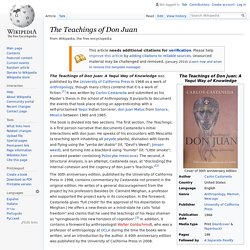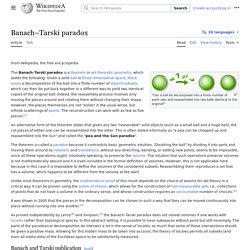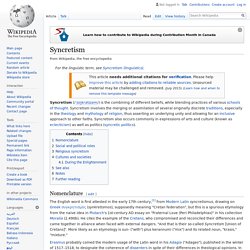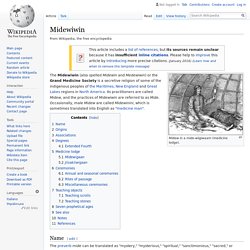

Spiritual materialism - Wikipedia. Conventionally, it is used to describe capitalist and spiritual narcissism, commercial efforts such as "new age" bookstores and wealthy lecturers on spirituality; it might also mean the attempt to build up a list of credentials or accumulate teachings in order to present oneself as a more realized or holy person.[2] Author Jorge Ferrer equates the terms "Spiritual materialism" and "Spiritual Narcissism",[1] though others draw a distinction, that spiritual narcissism is believing that one deserves love and respect[3] or is better than another[4] because one has accumulated spiritual training instead of the belief that accumulating training will bring an end to suffering.

Lords of Materialism[edit] Physical materialism is the belief that possessions can bring release from suffering. In Trungpa's view, they may bring temporary happiness but then more suffering in the endless pursuit of creating one's environment to be just right. Ego[edit] References[edit] External links[edit]
The Teachings of Don Juan - Wikipedia. The Teachings of Don Juan: A Yaqui Way of Knowledge was published by the University of California Press in 1968 as a work of anthropology, though many critics contend that it is a work of fiction.[1] It was written by Carlos Castaneda and submitted as his Master’s thesis in the school of Anthropology.

It purports to document the events that took place during an apprenticeship with a self-proclaimed Yaqui Indian Sorcerer, don Juan Matus from Sonora, Mexico between 1960 and 1965. The book is divided into two sections. The first section, The Teachings, is a first person narrative that documents Castaneda's initial interactions with don Juan. He speaks of his encounters with Mescalito (a teaching spirit inhabiting all peyote plants), divination with lizards and flying using the "yerba del diablo" (lit.
"Devil's Weed"; Jimson weed), and turning into a blackbird using "humito" (lit.
Why Not Be a Mystic?: Frank X. Tuoti, George A. Maloney: 9780824514532: Amazon.com: Books. Matthew 6:3 But when you give to the needy, do not let your left hand know what your right hand is doing, But when you give to the needy, do not let your left hand know what your right hand is doing, New Living TranslationBut when you give to someone in need, don't let your left hand know what your right hand is doing.

English Standard VersionBut when you give to the needy, do not let your left hand know what your right hand is doing, Berean Study BibleBut when you give to the needy, do not let your left hand know what your right hand is doing, Berean Literal BibleBut you, doing acts of charity, do not let your left hand know what your right hand is doing, New American Standard Bible "But when you give to the poor, do not let your left hand know what your right hand is doing, King James BibleBut when thou doest alms, let not thy left hand know what thy right hand doeth:
Korean shamanism - Wikipedia. The Isanmyo, a Sinist shrine built in 1925 to worship the four holy kings Dangun, Taejo, Sejong and Gojong.

It is one of the few surviving shamanic temples in Korea. Korean Muism has similarities with Chinese Wuism,[14] Japanese Shinto, Ainu religion and with the Siberian and Manchurian religious traditions.[14] In some provinces of Korea the shaman is still called dangul dangul-ari.[10] The mudang is similar to the Japanese miko and the Ryukyuan yuta. Muism has exerted an influence on some Korean new religions, such as Cheondoism and Jeung San Do. According to various sociological studies, many Christian churches in Korea make use of practices rooted in shamanism.[15] 478 ShonaghBreakingTheSpell.
The Gospel of the Kingdom - Google Books. People of Integrity are Transformed From the Inside Out - Watermark. Have you ever used the phrase, “don’t judge a book by its cover”?

What about, “beauty is only skin deep”? Both of these common phrases remind us that what we see on the outside isn’t always what’s on the inside. Looks can be deceiving and what you see may not be what you get. I’m sure you’ve interacted with people who, at first, look like they have it all together but eventually their true colors were revealed leaving others hurt, confused or disappointed. Men and women with true integrity are the same on the inside as they are on the outside. Amazon. Isaiah 30:15 This is what the Sovereign LORD, the Holy One of Israel, says: "In repentance and rest is your salvation, in quietness and trust is your strength, but you would have none of it. This is what the Sovereign LORD, the Holy One of Israel, says: "In repentance and rest is your salvation, in quietness and trust is your strength, but you would have none of it.

New Living TranslationThis is what the Sovereign LORD, the Holy One of Israel, says: "Only in returning to me and resting in me will you be saved. In quietness and confidence is your strength. But you would have none of it.
Banach–Tarski paradox. Can a ball be decomposed into a finite number of point sets and reassembled into two balls identical to the original?

A stronger form of the theorem implies that given any two "reasonable" solid objects (such as a small ball and a huge ball), either one can be reassembled into the other. This is often stated informally as "a pea can be chopped up and reassembled into the Sun" and called the "pea and the Sun paradox". Syncretism. Syncretism (/ˈsɪŋkrətɪzəm/) is the combining of different beliefs, while blending practices of various schools of thought.

Syncretism involves the merging or assimilation of several originally discrete traditions, especially in the theology and mythology of religion, thus asserting an underlying unity and allowing for an inclusive approach to other faiths. Syncretism also occurs commonly in expressions of arts and culture (known as eclecticism) as well as politics (syncretic politics). Nomenclature[edit] The English word is first attested in the early 17th century,[1] from Modern Latin syncretismus, drawing on Greek συγκρητισμός (synkretismos), supposedly meaning "Cretan federation", but this is a spurious etymology from the naive idea in Plutarch's 1st-century AD essay on "Fraternal Love (Peri Philadelphias)" in his collection Moralia (2.490b).
Social and political roles[edit] Religious syncretism[edit] Midewiwin. Midew in a mide-wiigiwaam (medicine lodge).

The Midewiwin (also spelled Midewin and Medewiwin) or the Grand Medicine Society is a secretive religion of some of the indigenous peoples of the Maritimes, New England and Great Lakes regions in North America. Its practitioners are called Midew, and the practices of Midewiwin are referred to as Mide. Occasionally, male Midew are called Midewinini, which is sometimes translated into English as "medicine man".
Name[edit] Black Elk. Heȟáka Sápa (Black Elk) (December 1, 1863 – August 19, 1950)[1] was a famous wičháša wakȟáŋ (medicine man and holy man) and heyoka of the Oglala Lakota (Sioux) who lived in the present-day United States, primarily South Dakota.

He was a second cousin of the war leader Crazy Horse. Near the end of his life, Black Elk met with amateur ethnologist John Neihardt and recounted to him his religious vision, events from his life, and details of Lakota culture. Neihardt edited a translated record and published Black Elk Speaks in 1932. Keyser soze devil quote. G444 - anthrōpos - Strong's Greek Lexicon (KJV) Strong's Greek: 444. ἄνθρωπος (anthrópos) Strong's Concordance anthrópos: a man, human, mankind Original Word: ἄνθρωπος, ου, ὁPart of Speech: Noun, MasculineTransliteration: anthróposPhonetic Spelling: (anth'-ro-pos)Short Definition: a man, one of the human raceDefinition: a man, one of the human race. HELPS Word-studies.
Things Are Changing Productions. Thelema. The word thelema is the English transliteration of the Koine Greek noun θέλημα (pronounced [θélima]) "will", from the verb θέλω "to will, wish, purpose. " As Crowley developed the religion, he wrote widely on the topic, producing what are collectively termed the Holy Books of Thelema. He also included ideas from occultism, Yoga and both Eastern and Western mysticism, especially the Qabalah.[8] Historical precedents[edit]
Rudolf Steiner's exercises for spiritual development. Rudolf Steiner developed exercises aimed at cultivating new cognitive faculties he believed would be appropriate to contemporary individual and cultural development. According to Steiner's view of history, in earlier periods people were capable of direct spiritual perceptions, or clairvoyance, but not yet of rational thought; more recently, rationality has been developed at the cost of spiritual perception, leading to the alienation characteristic of modernity.
Steiner proposed that humanity now has the task of synthesizing the rational and contemplative/spiritual components of cognition, whereby spiritual perception would be awakened through intensifying thinking.[1] A central principle of Steiner's proposed path to spiritual development is that self-development - inner transformation - is a necessary part of the spiritual path: "for every step in spiritual perception, three steps are to be taken in moral development. " Meditative path[edit] Supplementary exercises[edit] See also[edit] Manifestations of Karma. Borderlands of the Spirit: Reflections on a Sacred Science of Mind (Perennial Philosophy) - Kindle edition by John Herlihy. Religion & Spirituality Kindle eBooks @ Amazon.com.
What Is Chaos Magic? What Is Chaos Magic? "All great things must first wear a terrifying and monsterous mask, in order to inscribe themselves on the hearts of humanity. " -- Fredrick Nietzsche The words "Chaos Magic" reverberate with mystery and intrigue. It's rather safe to assume that this was intentional on the part of those who originally coined the term. Of course, when Gerald Gardener came up with his reconstruction of European Paganism in the 1950's and called it "witchcraft," he must have been equally well aware of the effect that that term would have on his contemporaries.
Imbolc 2014: Facts, Dates, Traditions And Rituals To Know. Subtle body.
Chimed Tsog Thik: The Abbreviated Practice of the Immortal Life Essence, by Ven. Gyatrul Rinpoche. By Ven Gyatrul Rinpoche. Buddha Mind, Buddha Body: Walking Toward Enlightenment: Thich Nhat Hanh: 9781888375756: Amazon.com: Books. Rudolf Steiner. An Original Essay on the Immateriality & Immortality of the Human Soul ... - Samuel Drew. Spiritual Master Free Spirit – Entering into Relationship with Star Beings – 8-12-14. Seeing in the Dark: Claim Your Own Shamanic Power Now and in the Coming Age - Colleen Deatsman. The Genesis According to Spiritism. The Genesis, Miracles and Premonition According to Spiritism (La Genèse, les Miracles et les Preditions selon le Spiritisme in the original French) was the last book published (1868) by Allan Kardec, just before his death.
It tries to reconcile science and religion and develops a series of important scientific and philosophical topics, relating them to Spiritism. Emerald Tablet.
Syncronic Order Law Of Time. Hermeticism. Lobsang Rampa. 777WFN6_2SpiritE. Chakras. Reincarnation. Perennial. Catholicism. Edgar Cayce. Edgar Cayce (/ˈkeɪsiː/; March 18, 1877 – January 3, 1945) was an American psychic who allegedly possessed the ability to answer questions on subjects as varied as healing, reincarnation, wars, Atlantis and future events while in a trance. These answers came to be known as "life readings of the entity" and were usually delivered to individuals while Cayce was hypnotized. Jnana. Jnana or gnana or gnaan (Sanskrit; Pali: jñāna) is a Sanskrit word that means knowledge. Spiritism. Theosophy. The Bible Wheel: A Revelation of the Divine Unity of the Holy Bible: Richard Amiel McGough: 9780977763771: Amazon.com: Books. Psalm 91 - Whoever dwells in the shelter of the. Manly Palmer Hall.
Yoga Sutras of Patanjali. The Immortal Body and Its Soul Powers by Ricardo B. Serrano, R.Ac.
Judaism. Islam. Mandala. Esoteric Christianity. Hinduism. Sex. Moonchild. Masters of Magical Powers: The Nāth Yogis in the Light of Esoteric Notions. Eroto-comatose lucidity. Yoga. Meditation. Buddhism. Bach, Chakras, Tarot: Toccata in F LINKS and footnotes page.